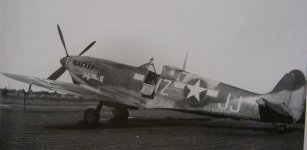Lord Londonderry
Banned
August, 1942 was the first time modest raids were made by the US 8th Air Force into France. The following is an extract from "Mustang Summer" by Jim Thorn.
"The first raid was on railway marshalling yards near Rouen and was led by Major Paul Tibbets in a B-17E, one of a dozen on that successful mission which managed to deliver 39.000lbs of bombs on target.......".
"Ironically, the raids actually concentrated on an area defended by crack Luftwaffe units but at least the American bombers had RAF Spitfire IXs offering fighter support. Unfortunately due to the latter's limited endurance it was a case of the bombers having to be on target with barely seconds to spare if they were to be assured of friendly fighter cover during the most perilous part of the mission."
"It was obvious from the beginning that fighters with significantly greater endurance than the Spitfire would be necessary if the bombers were to enjoy the luxury of fighter protection to and from targets inside Germany".
ENTER THE MUSTANG, the greatest fighter of the war, "not so much for what it was but more importantly for what it could do" - Jim Thorn, "Mustang Summer", a fantastic book about Mustangs and their pilots in operation over Europe in WW2.:box:
"The first raid was on railway marshalling yards near Rouen and was led by Major Paul Tibbets in a B-17E, one of a dozen on that successful mission which managed to deliver 39.000lbs of bombs on target.......".
"Ironically, the raids actually concentrated on an area defended by crack Luftwaffe units but at least the American bombers had RAF Spitfire IXs offering fighter support. Unfortunately due to the latter's limited endurance it was a case of the bombers having to be on target with barely seconds to spare if they were to be assured of friendly fighter cover during the most perilous part of the mission."
"It was obvious from the beginning that fighters with significantly greater endurance than the Spitfire would be necessary if the bombers were to enjoy the luxury of fighter protection to and from targets inside Germany".
ENTER THE MUSTANG, the greatest fighter of the war, "not so much for what it was but more importantly for what it could do" - Jim Thorn, "Mustang Summer", a fantastic book about Mustangs and their pilots in operation over Europe in WW2.:box:

